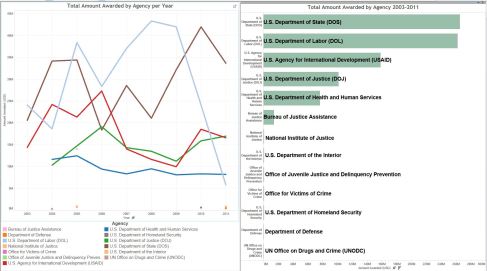Since the adoption of the United Nations (UN) Protocol to Prevent, Suppress and Punish Trafficking in Persons, especially women and children in 2000, the international, regional, and domestic legal frameworks to combat trafficking have coalesced around three principles: prosecution (punishing traffickers), protection (assisting and supporting victims), and prevention (public awareness and education to end trafficking) (Cho, Drehe, & Neumayer, 2012; UNODC, 2006; US DOS, 2012). In the US, since enactment of the Trafficking Victims Protection Act (TVPA) in 2000, federal agencies have supported hundreds of programs managed by private contractors, non-governmental organizations (NGOs), universities, and other groups. For instance, the US Department of State (US DOS) invested in different types of programs to combat human trafficking. Consider two illustrative investments by the US DOS. In 2004, the US DOS invested $300,000 in counseling, transportation, family tracing, and reunification services for child victims of human trafficking in Ghana (G/TIP, 2005). In 2007, the Department of State invested $125,000 in Gambia to train law enforcement and members of the judiciary to increase their skills and expertise in identifying and investigating trafficking crimes. The project also focused on developing the capabilities to treat victims and witnesses of trafficking, preserve evidence for prosecution, and form alliances with NGOs (G/TIP, 2008).
Given the significant amount of investments to combat human trafficking by federal agencies, the below figure shows changes in funding by individual US federal agencies from 2003-2011. The bar graph shows total funding by agency over that period. From the figure, it is clear that, US agencies have awarded fluctuating amounts of funding to combat trafficking over the years. For example, the total amount awarded by the US DOS rose from 2008-2010 and then fell from 2010-2011. In contrast, the total amount awarded by the US Department of Labor drastically dropped from 2010-2011. Generally, in 2011, US agencies allocated fewer funds towards anti-trafficking projects. While the figure illustrates the varying amount of investments over years by federal agencies, however, it is difficult to predict the underlying logic behind these varying levels of investments. No clear answer exists on why these funding levels vary so differently. Thus, further research is needed to understand the rationale behind investments made by these agencies to combat trafficking.
The figure was created using Tableau.
References
Cho, S. Y., Dreher, A., & Neumayer, E. (2012). The determinants of anti-trafficking policies–evidence from a new index. Retrieved May 8, 2013 from http://papers.ssrn.com/sol3/papers.cfm?abstract_id=2139583.
United Nations Office on Drugs and Crime. (2006). Trafficking in persons global pattern. Retrieved July 15, 2013 from http://www.unodc.org/pdf/traffickinginpersons_report_2006-04.pdf
United States Department of State. (2012). Annual Reports on Trafficking in Persons. Washington D.C: USA. Retrieved July 15, 2013 from http://www.state.gov/j/tip/rls/tiprpt/2012/.
